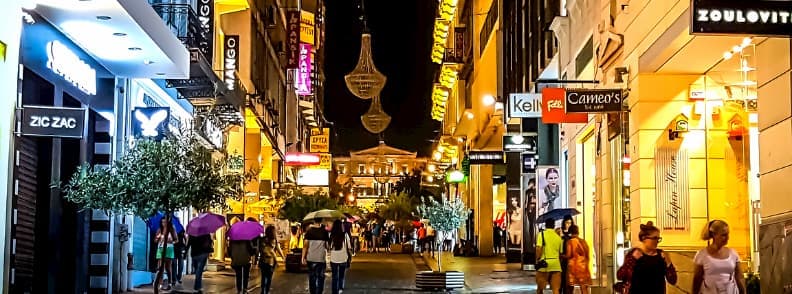Exploring the streets of Athens, Greece? This insider guide shows you exactly where to go, from the most famous streets in Athens like Ermou and Adrianou, to overlooked gems like Iroon Square in Psirri and Dexamenis Square in Kolonaki. I’ve wandered these Athens streets solo, with friends, in heatwaves and winter drizzle, always finding something new around the corner. You’ll get a neighborhood-by-neighborhood breakdown of the best streets in Athens, a walking itinerary through Athens’ main squares, and tips only a local would tell you (like where to sit under the trees in Agias Irinis Square or how to reach Avdi Square without getting lost).
This guide is for you if you’re planning a visit and want real help, not some vague lists or recycled clichés. I’ve combined personal experience with in-depth research (in Greek and English), and I’ll show you how to explore the streets of Athens Greece, in a way that’s more local, less crowded, and full of flavor. You’ll learn how to get around by metro and tram, what time to visit the Thissio outdoor market, and which Athens squares feel safe and welcoming after dark.
Athens Streets and Squares Guide
From Athens flea market Sundays to Athinas Street’s market chaos, from the slick marble of Syntagma Square to the indie cafés around Exarchia Square, this guide walks you through the Athens street hub with your eyes wide open. Start reading, and by the end, you’ll know how to move like a local.
Disclosure: Some of the links below are affiliate links. This means that at no extra cost to you, The Travel Bunny will earn a small commission if you click through and make a purchase. Thank you!
Why the Streets and Squares of Athens Deserve Your Full Attention
The streets in Athens are where daily life happens. They’re full of energy, contradictions, and small details that make the city unforgettable. And the squares in Athens? They’re where you’ll see the real face of the capital, from elderly chess players in Klafthmonos Square to student protests in Exarchia Square, to flower vendors in Agias Irinis Square.
I’ve walked through the streets of Athens Greece dozens of times. Each time feels different. The layers of history are visible as you move between neighborhoods. A quiet square turns into a pop-up market. A graffiti-filled alley opens into a polished pedestrian plaza. You’re not just sightseeing, you’re in it. If you skip the Athens squares and Athens city streets, you’re missing the pulse of the city.
Below, I’ll guide you through the best streets in Athens, linking each to its surrounding neighborhood and highlighting practical tips like public transport access, safety, and where to stop for coffee or something sweet. You’ll also find my favorite famous squares in Athens and lesser-known spots worth a detour. Whether you’re after Greek streets at night, budget shopping, or a quiet café with a view, it’s all here.
Plaka & Monastiraki, the Historic Heart of Athens
Ancient lanes, lively squares, and street life at the foot of the Acropolis
Plaka and Monastiraki form the oldest, most atmospheric part of the city. Together, they anchor what many call the historic center of Athens, sitting right below the Acropolis. This is where the city’s story unfolds in plain view, from Roman columns and Ottoman mosques to old tavernas and busy Athens squares packed with buskers, souvlaki stands, and antique dealers.
Plaka Is Where the Streets of Athens Whisper History
Plaka is all winding alleys, bougainvillea-draped balconies, and quiet side streets in Athens Greece that feel more like a village than a capital. This is where I go to slow down. Neoclassical houses painted in earthy tones, tiny Orthodox chapels, and worn stone steps lead to rooftops with Acropolis views.
You’ll find some of the most photogenic streets of Athens here, such as Lysikratous Street and the pedestrian sections of Tripodon and Kidathineon. Stop for a Greek coffee in Filomousou Eterias Square, one of the lesser-known squares in Athens, shaded and perfect for resting your legs. It’s quiet, mostly local, and always a peaceful break from the tourist trail.
Athens Local Tip: Start your morning in Plaka before the crowds roll in. I like to grab a freddo cappuccino from a corner café, sit in the square, and just watch the city wake up.
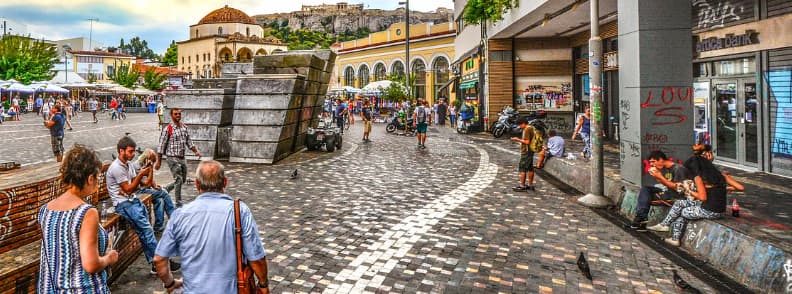
Monastiraki Has Flea Markets, Ruins, and Real Chaos
Monastiraki neighborhood is the loud, fast-moving counterpart to Plaka’s calm. Its centerpiece, Monastiraki Square, is one of the most famous Athens squares, and for good reason. It’s where modern street life collides with the layers of history of Athens: Ottoman mosques, Byzantine churches, and the Acropolis looming above.
Start from the square and head into the Monastiraki flea market (best on Sundays), winding your way through Avissinias Square, a spot famous for its antiques. You’ll find vintage furniture, old vinyl, coins, and probably someone trying to sell you a rusted phone from the 1980s. It’s chaotic, but in the best way.
Local Athens Tip: Visit around 10 am for the Athens flea market Sunday experience in full swing.
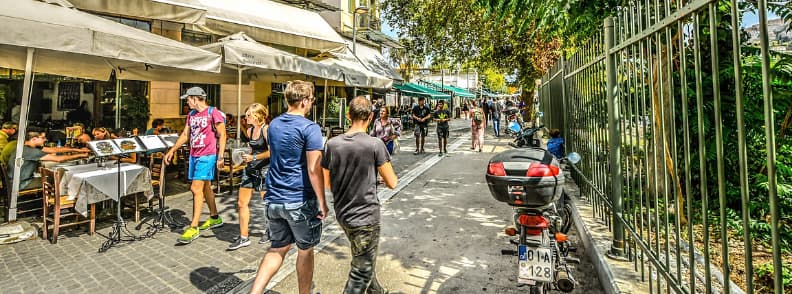
Adrianou Street for Ancient Sights and Taverna Nights
Adrianou Street is one of the oldest and most atmospheric streets in Athens, and it deserves your full attention. It stretches across both Monastiraki and Plaka, linking centuries of history with some of the city’s best food and views. In the Monastiraki section, it starts near Hadrian’s Library and hugs the edge of the Ancient Agora, continuing west toward the Thissio flea market. On one side, you’ve got ivy-covered tavernas with tables spilling into the street. On the other, open ruins and a full-on Acropolis view. It’s where archaeology meets ouzo.
Walk east, and Adrianou Street Athens threads deeper into Plaka, winding past artisan shops, old mansions, and small churches. Eventually, it connects to Lysikratous Street and Hadrian’s Arch, ending near the Temple of Olympian Zeus. You could walk the whole stretch in 30 minutes or take your time and spend all afternoon here, café by café, ruin by ruin.
Why I Keep Coming Back to Adrianou Street Athens
Evenings are when this street really comes alive. I love arriving just before dusk, when the light turns golden and the Acropolis starts to glow. The clinking of cutlery, soft live music from a nearby bouzouki trio, and the scent of grilled meat and oregano hanging in the air. Despite being a central location, it still feels laid-back. This is one of the best streets in Athens for a long dinner, with no rush or cars.
I’ve eaten here during summer heat and chilly out-of-season evenings. Each time, the energy is warm and easy. If you’re looking for streets of Athens that offer real flavor and scenery, this one’s it.
How to Get to Adrianou Street
To reach Adrianou Street, take the metro to Monastiraki station, served by both Line 1 and Line 3. From the station exit near Hadrian’s Library, you’ll find yourself right at the entrance to this iconic Athens street, with tavernas on your left and the Ancient Agora opening up to your right. If you’re arriving from the western side of the city, Thissio station on Line 1 also connects directly to the far end of Adrianou Street, closer to the Thissio flea market and the edge of the pedestrianized Apostolou Pavlou Street.
Coming on foot from Syntagma Square, follow Ermou Street Athens map downhill for about 15 minutes until you reach Monastiraki Square. From there, look for the stone mosque or the entrance to the flea market, and just beside it, you’ll spot the street sign for Adrianou. This stretch marks one of the most scenic and accessible streets in Athens Greece, perfectly placed between major Athens squares, archaeological sites, and local food spots.
Athens Insider Tip: The Monastiraki end is livelier in the evening, while the Plaka section is quieter and better for a calm lunch or photo walk. Both ends offer their own version of Athens at its best.
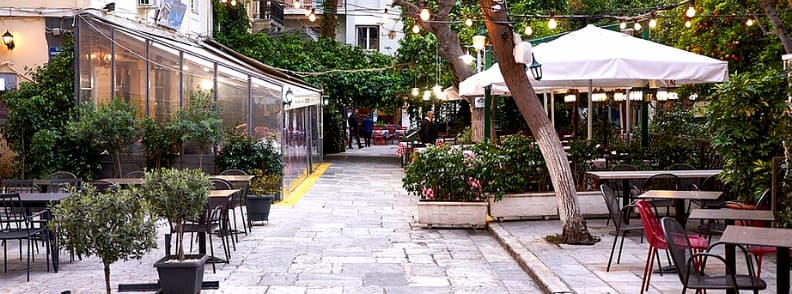
Filomousou Eterias Square (Plaka) for Café Culture in the Shade
One of the quietest and most charming squares in Athens, Filomousou Eterias Square sits at the heart of Plaka, hidden just enough to keep most tourists away. Its name translates to Friends of the Muses, and once you’re there, it makes sense. Surrounded by leafy trees, neoclassical buildings, and a mix of vintage and modern cafés, the square offers a peaceful break from the busy streets of Athens Greece. It’s small, shaded, and the kind of place you stumble into and end up staying for hours.
You won’t find souvenir stands or loud tour groups here. Instead, it’s locals meeting for morning coffee, university students working on laptops, and couples sharing a quiet lunch. It’s the kind of square in Athens that doesn’t try to impress, and that’s exactly why I love it.
Athens Local Tip: This is where I often start my day in Plaka. I’ll order an iced coffee, grab a seat at a sidewalk table, and ease into the morning while watching the square fill with life. It’s one of those Athens squares that still feels alive.
How to Get to Filomousou Eterias Square Athens
To get to Filomousou Eterias Square, take the metro to Syntagma (Line 2) or Monastiraki (Line 1 or 3). From either station, it’s about a ten-minute walk through the Athens city streets. The easiest route is down Ermou Street before turning south into the Plaka alleyways. It’s a bit hidden, and you might need to check Google Maps or ask a local for Plateia Filomousou, but the search is part of the experience. Once you find it, you’ll understand why it’s one of Plaka’s best-kept secrets.
Agias Irinis Square for Trendy Meetups by the Old Cathedral
Just a few blocks from the chaos of Monastiraki Square, Agias Irinis Square offers a cooler, calmer kind of buzz. It’s built around the 19th-century Church of Saint Irene, Athens’ first cathedral, and has quietly become one of the most stylish squares in Athens for eating, drinking, and people-watching. During the day, you’ll spot flower stalls under the trees and delivery bikes weaving between café tables. On Sundays, a small flower market sets up near the church, adding bursts of color and scent to the stone-paved square.
This is where I sometimes meet local friends, especially in the afternoon when the cafés start to fill with a creative, easygoing crowd. It feels young but not rushed. Chic but not expensive. You’ll find third-wave coffee spots, bakeries, wine bars, and casual restaurants all circling the square, and most of them spill onto the sidewalk. It’s where street Athens meets soft music, craft cocktails, and late breakfasts that stretch into the afternoon.
A Bit of Nostalgia: One of my favorite hangouts here used to be Poems n‘ Crimes, a hybrid café-bar-bookstore. I first wandered in on a quiet Sunday after hearing live jazz from the street. I stayed for an espresso, browsed the shelves, and returned that evening for a glass of wine and a short film screening. It was one of those places that felt like a creative retreat right in the middle of the Athens street hub. Sadly, it no longer exists.
How to Get to Agias Irinis Square
You can reach Agias Irinis Square in just five minutes from Monastiraki station (Lines 1 and 3). Walk north up Aiolou Street Athens, and the square will open up around you. From central locations like Ermou Street or Syntagma Square, it’s an easy stroll through the most walkable Athens streets. If you’re coming from Psirri or Kerameikos, it’s about a 10- to 15-minute walk east. The square sits at the intersection of Aiolou Street and Agias Irinis Street, making it a key meeting point in the growing network of creative spaces around central Athens.
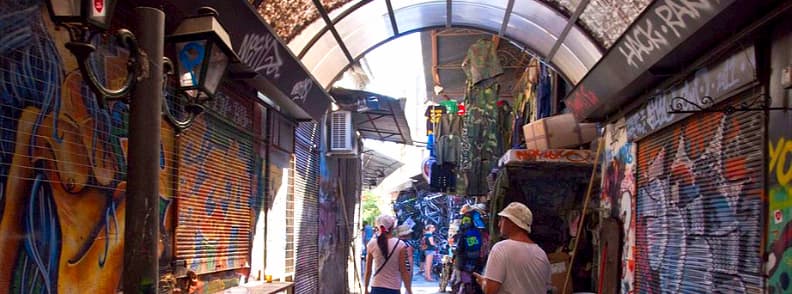
Monastiraki Square & Avissinias Flea Market for the Bazaar Atmosphere
Monastiraki Square is one of the main squares in Athens, and it’s where everything (and everyone) seems to collide. It’s loud, busy, a bit messy, and absolutely essential. Here you’re standing on layers of history: an old monastery, a 19th-century mosque, a Byzantine church, and the ever-present view of the Acropolis towering above. Around you, souvenir stalls, street performers, food carts, and bargain hunters all fight for your attention. It’s the beating heart of central Athens.
All the major streets of the Monastiraki neighborhood branch out from here (Ermou Street, Athinas Street, and Adrianou Street), which makes this square the perfect anchor point for exploring the surrounding Athens city streets. You’re just as likely to hear the clang of church bells as you are to be offered handmade jewelry, grilled corn, or a tarot reading.
A few steps away lies Abyssinia or Avissinias Square, the weekend home of the largest Athens flea market Sunday crowd. Every Saturday and Sunday, this corner of Monastiraki turns into a full-on open-air bazaar. You can rummage through stacks of vinyl records, old telephones, Byzantine icons, retro magazines, and quirky antiques. I’ve spent entire mornings there without realizing how much time had passed. Once, I left with a vintage Greek postcard and a bronze owl figurine I had absolutely no space for, but I’ve never regretted the find.
Athens Travel Tip: For a break from the square’s energy, sneak away to Couleur Locale, a rooftop bar on Normanou Street. You’ll sip something cold with a full view of the Acropolis and none of the crowds below. It’s my go-to escape when Monastiraki gets too intense.
How to Get To Monastiraki Square & Abyssinia Square
You’ll find Monastiraki station directly underneath the square, served by Metro Line 3 (from the airport) and Line 1 (from Piraeus). Step outside and you’re instantly in the middle of it all. If you’re walking from Syntagma Square, follow Ermou Street Athens map west for about 10 minutes. To reach Avissinias Square, just head west from the square along Ifestou Street or Pandrossou Street. You’ll spot the market stalls within two minutes. Sunday mornings are best for the full flea market Athens experience, but even midweek, there’s always something to see, hear, and eat.
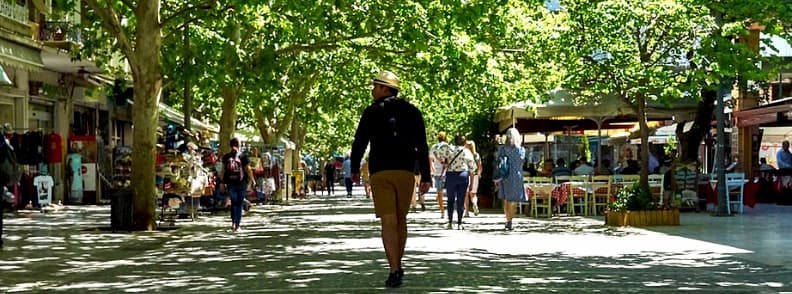
Dionysiou Areopagitou & Apostolou Pavlou for Athens’ Most Scenic Stroll
If I had to pick just one walk to introduce someone to Athens, it would be this. Dionysiou Areopagitou Street and Apostolou Pavlou Street together form a long, uninterrupted pedestrian promenade that wraps around the base of the Acropolis. This is often called the best street in Athens for a reason. It’s historic, scenic, and beautifully walkable. And the best part? No cars.
Start your walk at the east end of Dionysiou Areopagitou, near Hadrian’s Arch and the Temple of Olympian Zeus, and head west. The cobblestone path follows the southern slope of the Acropolis, offering a perfect mix of landmarks and local life. You’ll pass the Acropolis Museum, elegant neoclassical mansions, and a mix of musicians, artisans, and street vendors selling handmade jewelry and original art. The buildings here are some of the most photographed in the Athens city streets, and the atmosphere is relaxed but full of movement.
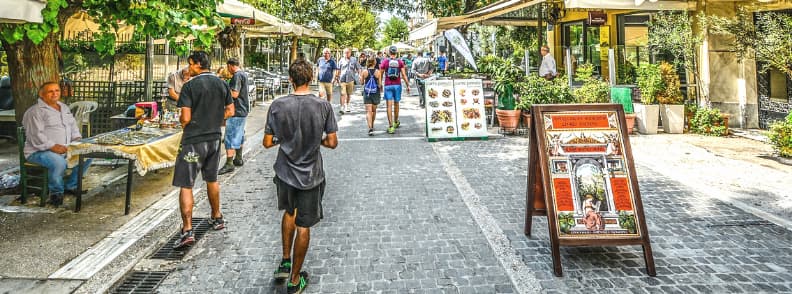
As you continue, the street curves into Apostolou Pavlou Street, leading you toward Thissio neighborhood, one of the liveliest neighborhoods in central Athens. This stretch is where the Parthenon looms above you and the Ancient Agora unfolds below. It’s hard not to stop every few meters for a photo or just to stare. There’s history, yes, but also street Athens in its most alive and local form: open-air cafés, families strolling, older Athenians chatting on benches, and travelers pausing for a midday beer or gelato.
Athens Insider Tip: I always recommend doing this walk around sunset. The light hits the stones just right, the air cools down, and Athenians love to take a walk here after work or before dinner. Grab a koulouri from a street vendor near the museum or a pistachio gelato from Lartecono Gelato Davinci, and just join the flow. On Sundays, look out for small artisan markets near Thissio, with local makers selling jewelry, prints, and leather goods.
For a break, stop at one of the cafés along Apostolou Pavlou Street. Most have terraces spilling into the walkway and clear views of the Acropolis above. This is one of the few places where sipping a coffee outside feels as rewarding as any guided tour. And if you’re up for a climb, detour at the Philopappos Hill entrance off Areopagitou. It’s an easy 15-minute hike that rewards you with panoramic views across Athens all the way to the sea.
How to Get to Dionysiou Areopagitou & Apostolou Pavlou Streets in Athens
To get here, take the metro to Akropoli station (Line 2) to start at the eastern entrance of Dionysiou Areopagitou Street. From the west, Thissio station (Line 1) brings you right to the beginning of Apostolou Pavlou Street. If you’re already in Plaka, the promenade is a few minutes away on foot, making it one of the most seamless connections between streets in Athens and its major sites. The whole route is pedestrianized, so it’s safe, car-free, and perfect for slow travel. Whether you walk it start to finish or just dip into a part of it, this is the kind of street that stays with you.
Syntagma & Downtown Athens, Grand Squares & Shopping Streets
From Parliament and posh avenues to market streets connecting Syntagma and Omonia
If Plaka is the city’s old soul, then Syntagma Square and Omonia Square are its forward-moving pulse. These two landmarks define the modern downtown and anchor the most walked and worked-through Athens city streets. In between, you’ll find some of the most famous squares in Athens, plus an ever-changing mix of neoclassical elegance, gritty market energy, and upscale shopping strips.
This part of the city is where the contrast hits hardest and best. One minute you’re walking past designer stores near Kolonaki Square, and the next you’re plunged into the sights and smells of Athinas Street, shoulder-to-shoulder with locals picking up herbs and feta. You’re never more than a few blocks from a new rhythm.
The area is compact and mostly walkable. The grid here makes it easier to navigate than the winding streets of Athens Greece near the Acropolis. If you take the time to explore the side streets off Panepistimiou Boulevard or the alleys behind Ermou Street, you’ll find everything from hidden cafés and retro bookstores to secret rooftop views and unexpected local tavernas.
Local Athens Advice: Use the Athens squares as your orientation points. Start at Syntagma Square to get your bearings, then walk west to Monastiraki, or north toward Omonia Square and beyond. The transition from glossy to gritty is fast, but that’s part of Athens’ charm. It’s a city that lets you see all its layers within minutes if you’re paying attention.
In the sections that follow, I’ll take you through each key square and street, highlight what makes them essential, and help you move through the main square in Athens and its web of connecting routes like a local. Expect both high and low: elegant hotels, protest marches, high-end retail, hole-in-the-wall bakeries, and a real sense of a city that never stops evolving.
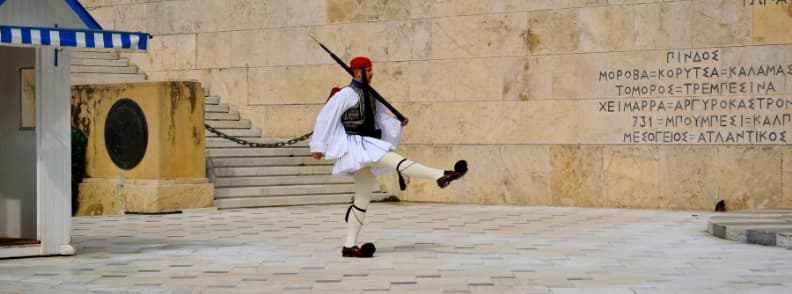
Syntagma Square, Athens’ Main Square & Political Hub
Syntagma Square, which means Constitution Square, is the undisputed heart of modern Athens. It’s more than just a meeting point or a photo stop. This is the main square in Athens, where political events, public celebrations, daily commutes, and quiet moments all happen side by side. You’ll find it directly in front of the grand Hellenic Parliament, making it one of the most important squares in Athens both symbolically and practically.
The square’s most famous draw is the Changing of the Guard ceremony at the Tomb of the Unknown Soldier, guarded by the Evzones in traditional dress. The synchronized, high-kicking performance happens on the hour, every hour, rain or shine, and is surprisingly moving to watch. It’s one of those rituals that never feels like a gimmick. It reflects something deeply Athenian: pride, resilience, and ceremony in the middle of city life.
What many people miss lies underneath: the Syntagma Metro station houses a mini-museum of archaeological finds uncovered during construction. You can walk past fragments of ancient aqueducts and tombstones while waiting for your train. Above ground, the square is often a stage for what’s happening in the country: student protests, holiday concerts, impromptu performances. And always, pigeons. Lots of pigeons.
Local Athens Tip: I often pass through Syntagma Square multiple times a day, but if there’s music or a crowd gathering near the central fountain, I’ll stop. It could be a high school dance group, a jazz trio, or simply a family enjoying the early evening light. At night, the Parliament building is beautifully lit, and the square feels safe and open.
How to Get to Syntagma Square
To get here, take the metro to Syntagma station on Line 2 or Line 3. You’ll emerge directly onto the square, it’s impossible to miss. The airport bus X95 also terminates here, making it the most convenient arrival point if you’re staying in the center. Most streets in Athens Greece lead toward or away from this square, especially Ermou Street, which begins here and runs west to Monastiraki. The tram lines from the Athenian Riviera end at Syntagma as well, and dozens of buses stop along Leoforos Amalias, which borders the square.
This is your orientation point, the literal and symbolic center of Athens. Almost everything you need connects here.
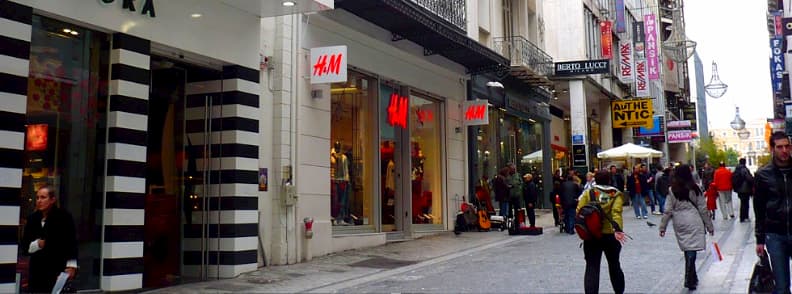
Ermou Street for a Shopping Spree on Athens’ Famous Street
If you’re walking from Syntagma Square to Monastiraki Square, you’re likely already on Ermou Street, one of the most famous streets in Athens and easily the busiest shopping boulevard in the country. Spanning around 1.5 km, it’s fully pedestrianized and lined with global chains, Greek department stores, and small boutiques, all packed tightly into what is officially one of the most expensive retail streets in Europe. Fitting, since “Ermou” is named after Hermes, the Greek god of commerce.
Ermou Street Athens map puts you in the middle of it all. The eastern half near Syntagma is polished and international. Zara, Mango, Sephora, Nike, and other global brands dominate the storefronts. But keep walking toward Monastiraki, and the mood shifts. The shops become more local, more tourist-focused, and more chaotic in the best way. You’ll start to see souvenir stands, olive oil soaps, leather sandals, and knockoff sunglasses side by side with artisan jewelry and embroidered linen shirts.
Right in the middle of the street, you’ll encounter Kapnikarea Church, a tiny 11th-century Byzantine chapel that has somehow survived centuries of change. Nestled between H&M and the city’s constant hum, it’s a quiet anchor in the retail storm and one of my favorite contrasts in the city. Every time I pass it, I stop, even for just a moment.
How to Get to Ermou Street
To get to Ermou Street, start from either Syntagma Station (Line 2 or 3) at the eastern end or Monastiraki Station (Line 1 or 3) at the western tip. The entire street is easy to walk, level, and busy day and night. Coming from Plaka, just walk north a couple of blocks and you’ll hit the eastern section of Ermou. Look for the shopping crowds and follow them.
Whether you’re hunting for the perfect Greek sandals, browsing global fashion brands, or just soaking up the atmosphere, Ermou Street gives you a front-row seat to modern Athens. It’s commercial, yes, but it’s also vibrant, local, and very much alive.
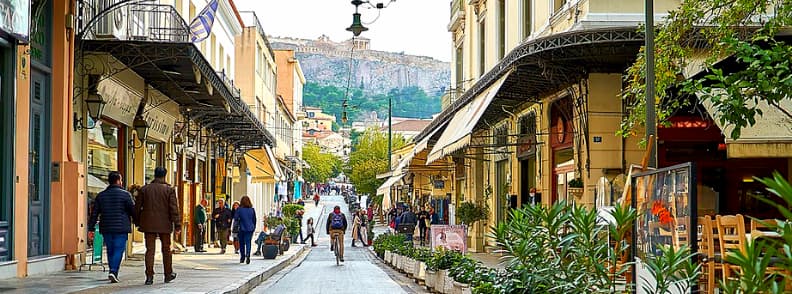
Aiolou & Athinas Streets, Old Market Streets Connecting the City
If Ermou Street is the commercial spine of central Athens, then Aiolou Street and Athinas Street are its working lungs, pumping with street life, smells, sounds, and the kind of sensory overload that makes you feel like you’re really in Athens. Running roughly parallel through the heart of the city, these two Athens city streets link Omonia Square to Monastiraki Square, and they couldn’t be more different from the polished storefronts just one block away.
Aiolou Street Athens holds a bit of history: it was the first paved street in Athens, back in the 19th century, and later became one of the city’s first pedestrian zones. Its name comes from Aiolos, the Greek god of winds. Early Athenians thought the Tower of the Winds in the Roman Agora was built in his honor. Today, Aiolou is lively and very walkable, especially around Agias Irinis Square, where cafés spill out onto the pavement and locals linger over iced coffee. It’s a place where traditional pastry shops sit next to modern brunch spots, and nothing feels forced.
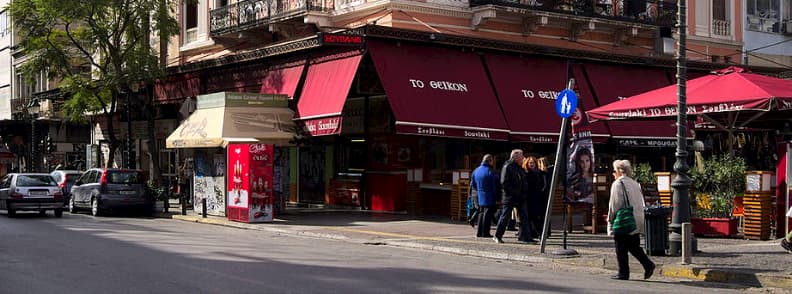
Athinas Street, just one block west, is louder, grittier, and full of character. It connects Omonia Square to Monastiraki, cutting through the city’s market district. Here, you’ll pass Athens City Hall, spice shops, fabric sellers, plastic household goods, and a steady flow of Athenians getting errands done. About halfway down, you’ll reach the beating heart of the street: the Athens Central Market (Varvakios Agora). This indoor market is a must-see for foodies. It’s raw, it’s noisy, and it’s packed with fishmongers, butchers, olive vendors, and shoppers shouting over slabs of lamb and crates of oranges. In spring, purple jacaranda trees line the sidewalks, softening the concrete and giving the whole street a splash of unexpected color.
Athens Local Tip: On Aiolou, don’t miss Falafellas, a tiny falafel shop with a perpetual queue for a reason. It’s delicious, fast, and budget-friendly. For something sweet, grab a bougatsa (custard-filled pastry dusted with powdered sugar) from a traditional bakery nearby. Over on Athinas Street, if the meat stalls get too intense, slip into Epirus Tavern inside the market. They serve classic dishes like beef soup and oven-baked lamb that locals swear by. It’s loud, steamy, and unforgettable.
How to Get to Athinas Street & Aiolou Street in Athens
To reach these streets in Athens, take the metro to Omonia station (Lines 1 and 2) and walk south. You’ll find yourself at the top of both Aiolou and Athinas. If you’re closer to the center, Monastiraki station (Lines 1 and 3) places you at the southern end of both streets. From Syntagma Square, it’s about a 10-minute walk west via Panepistimiou or Stadiou Street. Both Athinas Street Athens and Aiolou Street Athens are easy to locate on any Athens street map, forming part of the city’s historical and functional grid just a short distance from the capital’s most famous landmarks.
Walk both if you can. They may not be beautiful in the traditional sense, but they’re real, raw, and give you a sense of Greek streets that still put everyday life front and center. This is the Athens you’ll remember long after the guidebooks fade.
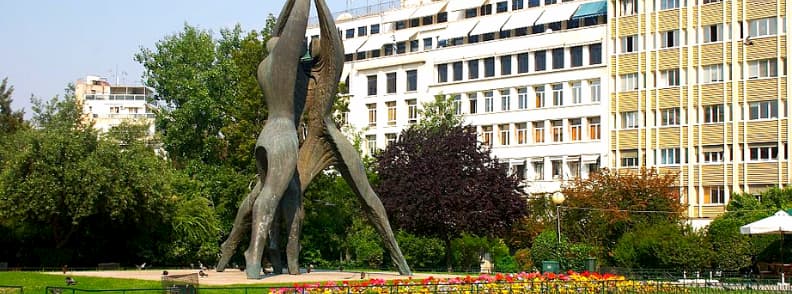
Klafthmonos Square. History and Hangouts on Stadiou
Just a few minutes’ walk from Syntagma Square, Klafthmonos Square sits quietly behind the crowds and headlines. Its name means “Square of Laments,” a nod to its curious 19th-century history when dismissed civil servants and defeated politicians would gather here to mourn their fall from power. That may sound theatrical, but in modern Athens, the vibe is far more casual, though the square still retains a touch of drama.
Klafthmonos Square is medium-sized and centrally placed, surrounded by government buildings like the Ministry of Interior, neoclassical facades, and business offices. It remains a key square in Athens for civic gatherings like open-air art installations, protest rallies, and occasional festivals that pop up here without warning. There’s a notable modern art sculpture at its center, the Trilogy of Drachma, referencing Greece’s former currency and economic transformations. The square’s layered symbolism makes it a subtle but meaningful stop on your walk through Athens streets.
What I love about Klafthmonos is that it feels unfiltered. It’s not dressed up for tourists. You’ll see ministry employees having lunch on benches, teens gathering with iced coffees after class, and musicians playing a jazz set out of nowhere on a warm evening. It’s the kind of place that blends old Athens with daily urban life. It’s one of those Athens squares that reveals itself slowly if you give it a little time.
Visit Athens Tip: If you’re in the area during lunch hours, grab a souvlaki from a side street grill and eat it on a bench here under the trees. Or check for posters on lampposts. Free cultural events are often announced at the last minute and held right in the square.
How to Get to Klafthmonos Square Athens
To get to Klafthmonos Square, the easiest route is from Panepistimio metro station (Line 2), which is about a five-minute walk via Korai Square. If you’re starting from Syntagma, walk west along Ermou Street for one block, then turn north up either Dragatsaniou or Kolokotroni Street. You’ll arrive at the square just before reaching Stadiou Street, one of the main Athens roads connecting Syntagma to Omonia Square. It’s not a flashy destination, but it’s firmly part of the everyday rhythm of the Athens city streets, a great place to pause between more high-profile stops.
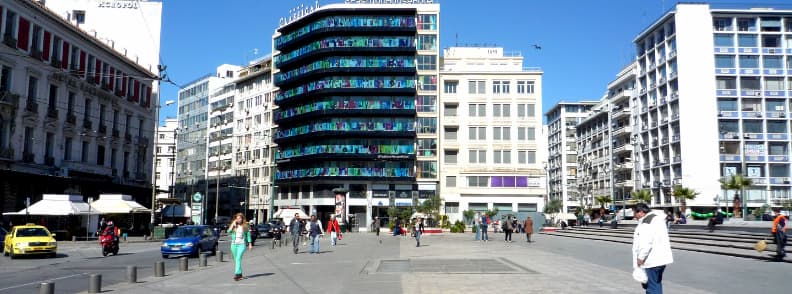
Omonia Square, the Gritty Revival in Athens’ Old Center
Omonia Square is one of the oldest and most historically loaded squares in Athens, and also one of the most complicated. Its name means Concord in Greek, but for decades, Omonia was better known for social tension than unity. First laid out in the 19th century as a grand roundabout modeled on European city planning, the square went from elegant to infamous over the years, becoming a gritty, neglected zone associated with crime, poverty, and decay.
That reputation hasn’t disappeared entirely, but Omonia Square has been slowly clawing its way back. A major facelift in 2020 added a massive illuminated fountain in the center of the roundabout, and it’s hard to miss, especially at night when the water show glows against the skyline. Some of the surrounding Athens city streets have also improved, with small-scale restorations and a few new businesses bringing life to the area. It’s still raw and real, but less bleak than it used to be.
Around the square, you’ll see a mix of classic old hotels, some restored, others still stuck in a faded past. The scene is never polished, but it’s undeniably urban. This isn’t where you come for a postcard shot of Athens. It’s where you come to understand how layered and uneven the city really is.
Athens Insider Tip: I won’t sugarcoat it. Omonia Square at night can still feel rough. If I’m visiting after dark, it’s usually with someone else, and I stay alert. That said, during the day it functions as a major metro and pedestrian hub, and you’ll find a steady flow of commuters and city workers moving through. One spot I absolutely recommend nearby is Stani, a traditional dairy bar on M. Kotopouli Street, just two minutes from the square. Their strained Greek yogurt with honey and walnuts is legendary and has been served the same way since the 1930s.
How to get to Omonia Square Athens
To get to Omonia Square, take the metro to Omonia station on Line 1 or Line 2. The station exits right onto the square, making it a key junction for moving through the city. If you’re walking from Syntagma Square, head north along Panepistimiou Street. It’s about 15 to 20 minutes on foot. From Athinas Street, simply walk north; the street literally dead-ends into Omonia Square, placing you near the fountain. This area is where several major Athens roads converge (Stadiou, Pireos, and Panepistimiou), so traffic is heavy and constant. Cross with care.
While Omonia may never reclaim the prestige it once had, it remains a crucial part of the city’s character. It’s where the polished meets the raw, and where transformation, even if slow, is still visible. If you’re curious about streets in Athens Greece that tell the full story, Omonia is worth at least a quick look.
Panepistimiou Boulevard, the Neoclassical Grandeur in the Heart of Athens
One of the most elegant Athens city streets, Panepistimiou Boulevard (officially Eleftheriou Venizelou Avenue but still widely known by its old name) is where Athens reveals its 19th-century European ambitions. This wide, grand avenue connects Syntagma Square to Omonia Square, cutting across the center of the city in a straight, symmetrical line. Lined with monumental buildings and marble colonnades, it’s where Athens feels more like Vienna or Paris, if only for a few blocks.
The boulevard gets its name from the word Panepistimiou, meaning “university,” and indeed it’s home to the city’s famed neoclassical trilogy: the University of Athens, the National Library of Greece, and the Academy of Athens. These three side-by-side architectural gems are among the most beautiful structures in the city. If you’re walking down the west side of the street, stop and look up. You’ll see the statues of Athena and Apollo standing tall above the Academy, symbols of wisdom and learning carved in stone. This trio is a perfect photo op and a reminder that modern Athens once dreamed big and built accordingly.
The surrounding section of Panepistimiou Street also holds more surprises. A few doors down from the Academy, you’ll find the Numismatic Museum, tucked behind a quiet gate. The museum itself is excellent if you’re into ancient coins, but even if you skip the exhibits, the garden café is a calm green hideaway in the middle of the city. It’s one of my favorite places for a mid-walk espresso. Nearby, the Attica department store sits in a neoclassical building of its own, filled with international brands and a surprisingly good rooftop café with skyline views.
Athens Insider Tip: When I have time, I duck into the modern wing of the National Library, located right behind the historic columns. It’s free to enter, and the glass-and-concrete design contrasts beautifully with the old façade. Inside, there’s often an art or photography exhibit and a peaceful place to read or rest your feet. Also, keep an eye out for the Academy of Athens doors. If they’re open, peek inside. The foyer is lavish, with mosaic floors and frescoed ceilings, and rarely crowded.
How to Get to Panepistimiou Boulevard Athens
To get here, take the metro to Panepistimio station (Line 2), which puts you right in front of the University building. From Syntagma Square, it’s a ten-minute walk northwest along this wide and formal stretch of Athens roads, with heavy foot traffic during the day. Omonia Square sits at the northern end of the boulevard, though that end is a bit less polished. Be sure to use pedestrian crossings (especially near Omonia), where the traffic can get unpredictable.
Panepistimiou Boulevard may not offer the café culture of Plaka or the market energy of Athinas, but it brings a different layer to Athens: one of ambition, intellect, and neoclassical pride. It’s one of the most important streets in Athens Greece, for understanding the city’s modern identity, built on knowledge, progress, and a good dose of marble.
Psirri & Metaxourgeio with Bohemian Streets & Creative Squares
Gritty meets artsy in two of the most interesting corners of central Athens: Psirri and Metaxourgeio. These backstreets were once avoided by tourists and even many locals. But over the past two decades, they’ve transformed into some of the city’s most dynamic areas. They’re still rough around the edges, but alive with art, music, and entrepreneurial energy. This is where you come to see what’s current in Athens culture, outside the museums and monuments.
Psirri is a compact neighborhood just north of Monastiraki Square, now known for its creative Athens street hub vibe. Think record shops, repurposed industrial spaces, rebetiko bars, and bakeries serving koulouri at 2 a.m. Graffiti is everywhere, and much of it is art rather than vandalism. You’ll find hidden galleries, vintage stores, and handmade leather workshops tucked into buildings that haven’t changed in fifty years.
A few blocks west lies Metaxourgeio, the quieter cousin, built around small squares and old industrial warehouses. This neighborhood is still in transition, but it’s home to independent theaters, edgy art spaces, and some of the most affordable and diverse food in central Athens. It’s also one of the greenest parts of downtown, with pop-up gardens and wide sidewalks perfect for wandering. The spirit here is DIY and community-first, giving it a different rhythm from the rest of the city.
Local Athens Tip: I love walking these neighborhoods just before sunset, when the street art glows and the cafés start to fill. If you’re into photography or people-watching, this is where the good stuff happens.
Let’s look closer at two central spaces that define the character of these creative neighborhoods.
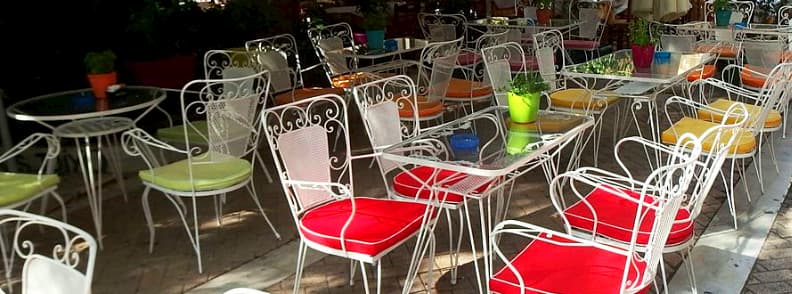
Iroon Square (Psirri) for Nightlife in a Street Art Canvas
Plateia Iroon, or Heroes’ Square, is the beating heart of Psirri, one of the most creative and unpredictable neighborhoods in Athens. This compact square isn’t grand or polished. It doesn’t have fountains or monuments. But what it does have is energy, and lots of it. Surrounded by graffiti-covered buildings, narrow alleys, and a tangle of bars and tavernas, Iroon Square feels more like a crossroads than a formal plaza, and that’s exactly what gives it life.
Psirri is often called the bohemian neighborhood of the city. Walk through it during the day, and you’ll spot vintage shops, experimental galleries, and walls turned into canvases. By night, everything shifts. Crowds fill the square, music drifts from open doorways, and groups hop between low-key tavernas, cocktail bars, and live music joints. Iroon Square Athens captures this shift perfectly. Its pavement becomes a dancefloor, a meeting point, a stage, and a hangout all at once.
It’s surrounded by old-school spots serving cheap eats and drinks, as well as newer venues that have embraced design, craft spirits, and modern Greek menus. And unlike other more curated parts of the city, Psirri hasn’t lost its rough edges. It remains one of the most raw, creative Athens street hubs, with a mix of authenticity and reinvention that draws artists, musicians, students, and travelers looking for something different.
My Athens Night-out Tip: Start with dinner at Oineas, a modern taverna with a local cult following just off the square. After eating, wander through Sarri Street and Pallados Street, two of my favorite backstreets for bold murals and stenciled slogans. I usually end up at Juan Rodriguez Bar or Tranzistor for cocktails. Both are packed with personality and people who aren’t trying too hard. If you’re lucky, you’ll hear the unmistakable strum of a bouzouki. Follow the sound to one of Psirri’s hidden rembetiko tavernas, where the music and mood feel like a scene from a black-and-white film.
How to Get to Iroon Square / Psirri Square
To get to Iroon Square, take the metro to Monastiraki Station (Lines 1 and 3). From there, walk north past Athinas Street, then duck into the lanes behind the small church on the edge of the square. You’ll probably hear music before you see where it’s coming from.
The square is also about a 10-minute walk from Omonia, though that route can be confusing. If you’re walking from Ermou Street, take Athinas Street, then turn into the maze of streets in Athens that define Psirri. Ask for Plateia Iroon, everyone local knows it. This is where Athens gets loud, gets late, and gets good.
Avdi Square (Metaxourgeio) for Art, Community & Green Space in Revival
In the heart of Metaxourgeio, just west of central Athens, Avdi Square (Plateia Avdi) is one of the city’s most authentic and creative public spaces. It’s not as famous as Syntagma Square or as central as Monastiraki, but in terms of grassroots culture, community energy, and artistic soul, it stands out. If you want to experience a square in Athens where the locals outnumber the tourists and everything from theater to tango might unfold on any given night, this is your spot.
Once a forgotten corner of a semi-industrial neighborhood, Avdi Square was redesigned in 2008 with trees, lighting, and open space. Since then, it’s grown into the cultural heart of Metaxourgeio, bordered by the Municipal Gallery of Athens, independent theaters, artist-run studios, and community cafés. It’s one of the most spacious squares in Athens, with wide lawns, a playful modern layout, and a relaxed vibe that encourages people to linger. What makes it special is how organically it has developed: not as a tourist attraction, but as a lived-in gathering place where creativity, activism, and daily life meet.
Around the square, the walls of Metaxourgeio are painted with striking murals and layered street art. Walk a few blocks in any direction and you’ll find the kind of visual storytelling that makes Athens streets such a canvas with social messages, portraits, and surrealist graffiti. And unlike some regenerated areas that feel polished and sanitized, Metaxourgeio still has its local edge. Artists and residents have kept its soul intact.
Athens Insider Note: One of my most unforgettable nights in Athens was at a spontaneous open-air milonga (an Argentine tango gathering), in Avdi Square. Dozens of couples danced under the stars to portable speakers, with onlookers clapping between songs. No tickets, no program, just music and movement. That’s what this square gives you: community without spectacle.
If you’re hungry, walk one block to Seychelles on Keramikou Street. It’s a local favorite, serving creative meze in a casual setting, and it’s always full for a reason. Nearby, Athens Street Hub (Kerameikou 111) is a container-style food court with burgers, beers, and often DJs spinning low-key sets. It’s where local life intersects with street culture, away from the big tourist drag.
How to Get to Avdi Square or Metaxougeio Square Athens
To get to Avdi Square, hop on Line 2 of the metro and get off at Metaxourgeio Station. From there, walk five minutes down Megalou Alexandrou Street, and the square will open up in front of you. If you’re coming from Psirri, head west along Ermou Street or Thermopilon Street. It’s a 10- to 15-minute walk through some uneven but interesting terrain. From the Kerameikos Gazi area, it’s also about 10 minutes north on foot. I recommend visiting during the day to explore the murals and art spaces, but evenings are when the square really comes alive with conversation, music, and movement.
Avdi Square is what I’d call a real success story of urban Athens: community-led, lived-in, and full of surprises. It’s not staged or packaged, but that’s its strength. In a city full of history, this is where the future gathers.
Visit Athens Tip: Psirri & Metaxourgeio are perfect for those seeking the local Athens beyond the ancient temples. The edgy, creative, and utterly authentic Athens. Don’t be afraid to explore these streets of Athens that many guidebooks skip. They might become your favorite part of the city
Kolonaki & Exarchia for Chic Squares and Counterculture Streets
Just northeast of Syntagma Square, two neighborhoods sit side by side but feel worlds apart. Kolonaki and Exarchia show off the extremes of modern Athens: upscale refinement on one hand, and raw resistance on the other. It’s this kind of contrast that makes walking through the streets of Athens Greece so fascinating. You don’t need a map to sense the shift. The pavement, the noise, the energy… It all changes within a few blocks.
In Kolonaki, polished stone sidewalks guide you past designer boutiques, art galleries, and stylish locals in linen shirts. This is the elegant face of Athens, with leafy Athens squares where café culture reigns supreme. Expect quiet luxury and glimpses of old-money Athens mixed with cosmopolitan flair. You’re as likely to overhear diplomatic talk as influencer chatter.
Just downhill (or uphill, depending on where you’re coming from), Exarchia flips the script. This is Athens’ rebellious core, where anti-fascist slogans cover the walls and conversations flow from anarchist bookstores and DIY cultural spaces. Here, it’s not about polish, it’s about voice. The streets in Athens don’t get more political, more expressive, or more honest than this.
Let’s take a closer look at each.
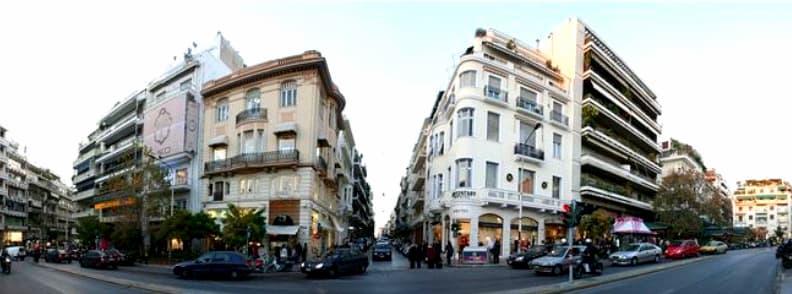
Kolonaki Square for Posh Strolling and Elegant People-Watching
Kolonaki Square (Plateia Kolonakiou) is the stylish core of Kolonaki, Athens’ most refined and upscale neighborhood. Located on the lower slopes of Lycabettus Hill, this small, leafy square is a social hotspot. The name comes from a tiny column (kolonaki) at its center, a relic from before the area grew into one of the capital’s most desirable districts.
This is the place to go if you want to experience the city’s luxury side, without the tourist show. The square in Athens is lined with designer boutiques, curated bookstores, and high-end cafés filled with diplomats, gallery owners, and well-dressed locals. But despite its elite reputation, Kolonaki Square remains surprisingly accessible. I’ve spent many relaxed mornings here, sipping a freddo espresso at Da Capo, a café that’s practically an institution. You’ll see everything from suited ministers to artists sketching quietly at the next table.
Strolling the surrounding Athens streets like Skoufa, Tsakalof, and Patriarchou Ioakim, you’ll pass sleek concept stores, art galleries, and posh bakeries. Kolonaki may be Athens at its most curated, but it’s also walkable, safe, and never sterile. It’s a slice of modern urban life with a European polish and a Greek soul.
Local Athens Tip: Head to Philos Café on Solonos Street for brunch with local style. And if you enjoy art, several private galleries nearby are free to enter. Just peek inside.
How to Get to Kolonaki Square
You can reach Kolonaki Square easily from Evangelismos metro station (Line 3), just a short downhill stroll. If you’re coming from Syntagma Square, it’s a 10-minute uphill walk via Voukourestiou Street. You’ll know you’ve entered Kolonaki when the shopfronts turn designer and the sidewalks shine.
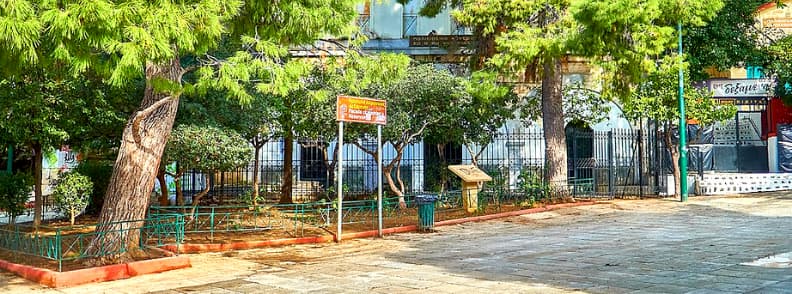
Dexameni Square with Cinema Under the Stars and a Quiet City Escape
Just a few minutes uphill from Kolonaki Square, Dexameni Square feels like another world. Tucked beneath the leafy slopes of Lycabettus Hill, this small, green space is one of the most relaxed and charming squares in Athens, loved by locals of all ages. The name Dexameni means cistern, and you’ll still find the remnants of a Roman reservoir here. However, today, it’s all about café culture and summer cinema.
Shaded by tall trees and framed by low stone walls, the square is a peaceful refuge from the city’s noise. You’ll find retirees reading the newspaper, children chasing pigeons, and couples meeting before a movie at Cine Dexameni, one of Athens’ best-loved open-air cinemas. Watching a classic or new release under the stars here is pure magic, especially on warm summer nights when the air is soft and the city lights flicker below.
The café in the square is old-school and relaxed, serving coffees, ouzo, and meze until late. It’s the kind of place where no one rushes, and regulars nod at each other as they arrive. If you’re looking for the greener squares of Athens, this one stands out for its shade, calm, and community feel.
Athens Insider Advice: Time your visit for late afternoon or early evening. Grab a snack at the café, then head into Cine Dexameni for the first film screening (check listings in advance because tickets sell out fast on weekends).
How to Get to Dexameni Square Athens
To reach Dexameni Square, you can take the Lycabettus funicular down from the hilltop, which drops you right nearby. On foot, climb Ploutarchou Street from Kolonaki (steep, but worth it) or use the steps just behind the Athens College building. From Evangelismos metro station, it’s about a 10-minute walk through residential streets. It’s close to everything but always feels like a hidden corner of the city.
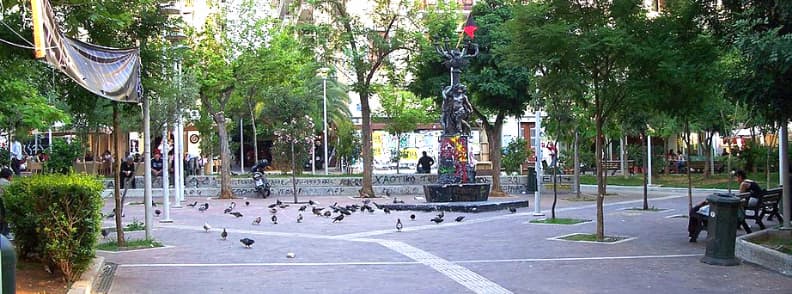
Exarchia Square, Athens’ Rebel Spirit and Creative Soul
If Kolonaki is all espresso and elegance, Exarchia Square is its raw and radical opposite. Nestled in the heart of Exarchia, Athens’ legendary alternative quarter, this square may look modest, but it’s one of the most politically charged and culturally significant squares in Athens. Known as a haven for nonconformists, Exarchia Square is where students, artists, intellectuals, punks, and anarchists gather to talk, argue, read, perform, and resist. And despite what you may hear, it’s more welcoming than intimidating, if you’re open to what the neighborhood stands for.
The square itself isn’t pristine. You’ll see graffiti everywhere: on benches, walls, even the trees. But the layers of tags and posters tell a story. Walk just a few meters and you’ll pass old-school vinyl shops, legendary leftist bookstores like Politeia, vegan eateries, smoky jazz cafés, and dive bars that look like time forgot them (on purpose). Streets like Valtesinou, Themistokleous, and Navarinou are saturated with street art. Some angry, some beautiful, all of it expressive. And on Sundays, a small open-air market pops up near the square with vintage finds, handmade crafts, and zines you won’t see anywhere else.
My experience: I’ll be honest, I was hesitant the first time I came to Exarchia. The reputation, especially in foreign media, paints a dramatic picture. But after that first visit, I kept coming back. I’ve spent quiet afternoons in Navarinou Park, a reclaimed parking lot turned urban garden by local activists. Evenings at a bar, sipping ouzo while a rebetiko duo played in the corner. I’ve watched debates spill from cafés onto sidewalks. Yes, it’s edgy. But it’s also full of life, ideas, and the kind of raw honesty that’s hard to find in more polished areas of the city.
How to Get to Exarchia Square Athens
To get to Exarchia Square, take the metro to Panepistimio station (Line 2) or Omonia station (Lines 1 and 2). From Panepistimio, the walk is about 8 minutes and passes the National Library of Greece, a well-lit and more comfortable route, especially in the evening. If you’re coming from Kolonaki, it’s a 15-minute walk west along Solonos Street, and the transition is striking: luxury storefronts give way to revolutionary slogans in just a few blocks.
Safety note: Exarchia is not dangerous, but it’s not polished either. At night, stick to main lit streets like Akadimias and Tzavella, and if you’re unsure, ask a local for directions. What you’ll find is a mindset, a neighborhood with an opinion, a voice, and a community that’s very much alive. Exarchia isn’t for everyone, but for those willing to look past the surface, it’s one of the most honest experiences in street Athens.
Kolonaki and Exarchia demonstrate Athens’ wonderful contrasts. Don’t hesitate to enjoy a morning coffee in Kolonaki Square and an evening drink in Exarchia Square. It’s all part of the Athens mosaic!
Pangrati & Kallimarmaro, Up-and-Coming Creative Neighborhood
A local’s playground near the Panathenaic Stadium with artsy cafes and authentic everyday life
Just behind the Panathenaic Stadium (known locally as Kallimarmaro), Pangrati is one of the few Athens neighborhoods that still feels genuinely local while welcoming change. Long known as a middle-class district with literary and artistic roots, Pangrati has evolved into a creative enclave full of life. It hasn’t been polished to the point of losing its soul. Instead, it’s grown into a relaxed, walkable area with tree-lined Athens streets, small cultural spaces, and squares that fill with locals from morning to night.
This neighborhood doesn’t have ancient ruins or flashy landmarks, but that’s the point. It’s where Athenians live, work, meet, argue over politics, and sip coffee for hours. It’s a slower Athens, with a bit of indie grit, and it’s only recently started to appear on visitors’ maps. If you want to see what everyday urban life looks like in one of the city’s most livable districts, Pangrati is where to go.
You’ll find narrow pedestrian lanes full of barbershops, bakers, and vinyl record stores. Graffiti isn’t rare, but neither is green. Pangrati is known for its many pocket parks and shaded squares. It’s particularly popular with students, designers, and young families, many of whom were priced out of nearby Kolonaki and settled here. And yes, the coffee scene is excellent.
Athens Foodie Tip: Come hungry. Pangrati’s food scene is growing fast. Creative Greek small plates, vegan bistros, artisan pizza, and coffee bars that take their beans seriously. Prices are fair, and the service is casual, in the best way.
Let’s hop to its main hangout spot.
Varnava Square, Pangrati’s Social Core Behind the Stadium
Varnava Square (Plateia Varnava) is Pangrati’s heart. It’s a low-key but lively plaza just steps from the back entrance of the Panathenaic Stadium. It’s not grand, and it won’t win any beauty contests, but it absolutely wins on vibe. Surrounded by small bars, souvlaki joints, bakeries, and an ever-evolving mix of café-bars, Varnava Square is the kind of place where everyone knows someone.
Day or night, this is where people gather. In the morning, locals sip coffee while dogs nap under the tables. In the afternoon, kids ride scooters across the pavement while delivery drivers shout orders from the sidewalk. And by evening, the square hums with groups of friends sharing beers, mezze, or just conversation until late. There’s no pretense here, it’s authentic and sociable, and it’s probably the best place in the area to get a read on the Athens street scene outside the center.
Athens Food & Drink Tip: For a proper sit-down meal, head to Mavro Provato just off the square, one of the most consistently excellent modern Greek restaurants in Athens. For something more casual, grab a bite or a cocktail from a retro-themed bar. Pangrati also has some standout bakeries, including Takis Bakery, a local favorite not far from here.
How to Get to Varnava Square
Getting to Varnava Square is easy. If you’re already visiting Kallimarmaro Stadium, just walk around the back via Ardittou Street or the stairs that descend from the hill. From Syntagma Square, it’s about 20 minutes on foot through the National Garden, past the Presidential Mansion and Zappeion. You can also take the metro to Evangelismos station (Line 3) and walk south past Rizari Park. Buses from the center (like the 209) and trams to Zappeion also stop nearby.
Varnava Square is a perfect example of the city’s in-between spaces, where nothing much happens on paper, but everything unfolds in real time. It’s one of the best squares near me if I’m in the center and want to feel like I’m part of local life again. Add it to your walk, your afternoon break, or your dinner plan. You’ll see why Pangrati is fast becoming one of the best streets in Athens for those who like their travel a little slower, and a lot more real.
Athens Travel Tip: Exploring Pangrati feels like discovering a secret local side of Athens. It’s not on the typical tourist list, but it rewards those looking for genuine Greek neighborhood life, plus great food and coffee. If you have an extra afternoon or evening, do what I do: wander Pangrati’s streets, relax in its squares near me in that area, and soak up the everyday Athens vibe
Recommended Walking Itinerary: Athens Streets & Athens Squares
If you’re short on time or want to experience the best streets in Athens and the most atmospheric Athens squares in one full day, this walking itinerary gives you the complete picture. It’s designed to flow naturally, linking iconic landmarks with lively Athens city streets, quiet neighborhoods, and spots for coffee, food, and sunset views. Expect about 5–6 km of walking, broken up by stops and meals. It’s easily manageable if you’re wearing decent shoes and pacing yourself.
This route is your introduction to the Athens street hub: historic, bohemian, elegant, rebellious, and always fascinating.
1. Morning at Syntagma Square
Start your day around 9:00 AM at Syntagma Square, the main square in Athens and the symbolic center of modern Greece. Grab a takeaway freddo coffee from Gregory’s or one of the small kiosks on the square. At 10:00 AM sharp, watch the Changing of the Guard in front of the Hellenic Parliament, a unique performance by the Evzones that happens on the hour, every hour. It’s both ceremonial and surprisingly powerful.
Before moving on, pop inside Syntagma Metro Station to check out the underground display of ancient tombs and aqueducts discovered during construction. This is one of the rare Athens squares where the past literally lies just beneath your feet.
2. Stroll Down Ermou Street to Monastiraki
Leave the square and begin your walk west along Ermou Street, the most famous shopping street in Athens. This pedestrian avenue is lined with a mix of international brands, local boutiques, street musicians, and churches tucked between storefronts. Don’t miss the tiny 11th-century Kapnikarea Church, sitting right in the middle of the road like it’s daring the shops to outshine it.
In 10–15 minutes, you’ll arrive at the chaotic and iconic Monastiraki Square. You’ll know it by the flood of people, the old mosque, and the Acropolis towering above. If it’s Sunday, swing into Avissinias Square to browse the Athens flea market Sunday scene with antiques, vinyl, secondhand books, and things you didn’t know you wanted.
3. Lunch in Plaka or Psirri
Around midday, you’ll be ready for lunch. You have two great options nearby:
- Plaka/Monastiraki. Head south from Monastiraki into Adrianou Street and get lost in Plaka’s maze of narrow, neoclassical streets in Athens Greece. For a traditional Greek meal in a village-like setting, grab a table at Scholarhio or Yiasemi.
- Psirri. If you’re in the mood for trendier, creative Greek food, loop north into Psirri and grab lunch at Ta Karamanlidika tou Fani on Evripidou Street. Think aged cheeses, house-cured meats, and a room full of locals.
Either way, take your time. Greek lunches aren’t rushed, and you’ll need energy for the afternoon walk.
4. Afternoon Acropolis Area Walk
After lunch, make your way to Dionysiou Areopagitou Street, one of the most scenic streets of Athens. From Plaka, cut through Lysikratos Street to reach the Acropolis Museum entrance. From here, begin your slow walk west along this beautiful pedestrian path. You’ll pass classical mansions, street musicians, and the impressive modern lines of the Acropolis Museum.
Continue onto Apostolou Pavlou Street, which curves gently through Thissio, offering incredible views of the Ancient Agora and Parthenon above. Around 5:00 PM, head up to the Pnyx or Philopappos Hill if you’re up for a short hike. The cityscape views are worth the climb.
5. Sunset at Areopagus Hill or a Rooftop Bar
For sunset, two unbeatable options:
- Climb Areopagus Hill (Mars Hill), a rocky outcrop just below the Acropolis entrance. It’s a local favorite for golden-hour views over Athens, especially when the sky turns violet over Lycabettus Hill.
- Or, head back toward Monastiraki Square and grab a table at a rooftop bar like A for Athens or 360 Cocktail Bar. The drinks aren’t cheap, but the view of the Acropolis at night is priceless.
Local Athens Tip: If Areopagus is too crowded or you want a quieter scene, head slightly west and find a bench near Philopappos Monument. It’s higher up and offers equally dramatic views with fewer people.
6. Dinner and Nightlife in Psirri or Exarchia
By now, you’re ready for dinner and some nightlife. Return to Psirri, near Iroon Square Athens, where you’ll find excellent tavernas like Oineas or Bandiera. This area fills with young locals every evening, and you might stumble onto live bouzouki music from an old-school rebetadiko.
Still have energy? For a completely different vibe, walk (or taxi) 10–15 minutes north to Exarchia Square. It’s the city’s anarchic and artistic core, filled with Athens streets covered in graffiti and energy. Grab a beer at Closer Reloaded Bar for a punk rock crowd or head to an Exarchion Rooftop Bar for something more mellow. This neighborhood runs late, and the debates are just as lively as the music.
7. Back to Base
Wrap up your day with a short walk or taxi ride back to your accommodation. From Psirri or Exarchia, metro stations like Monastiraki, Omonia, and Syntagma are nearby and still running until around midnight. If it’s later, taxis are safe and easy to hail downtown.
Walking Distance
Roughly 5–6 km total, broken up by plenty of food, culture, and rest stops. Easy to handle even at a slow pace. Wear good shoes, carry water, and take breaks at cafés. You’ll be walking through the layers of ancient, modern, and rebellious Athens, all in one day.
Can you stretch this over two days or more? Absolutely. But if you’ve only got one, this Athens walking itinerary connects everything that matters: from grand Athens squares to bohemian backstreets, from Acropolis views to indie bars. This is the city in full color.
FAQs: Visiting Athens Streets & Athens Squares
Exploring the streets of Athens Greece is one of the most rewarding ways to experience the city with no ticket required. But if you’re visiting for the first time (or even returning), you might have questions. Which are the most famous Athens squares? Are some Athens streets better to walk on than others? Is it safe to explore street Athens after dark? This FAQ covers the essential things to know before setting off, from local tips on where to go and when, to how to move confidently between the city’s grand boulevards and back-alley gems. Whether you’re after architecture, culture, food, or just atmosphere, this guide helps you make the most of your time on the ground.
What are the most famous streets in Athens?
Some of the most famous streets in Athens include Ermou Street (the main shopping street), Adrianou Street (which runs through Plaka and Monastiraki), and Dionysiou Areopagitou Street, which wraps around the southern edge of the Acropolis. These streets of Athens combine history, commerce, and daily life. Others like Aiolou Street, Athinas Street, and Apostolou Pavlou Street connect key areas and give you a feel for the local rhythm of the city.
What are the main squares in Athens worth visiting?
Start with Syntagma Square, the political and transportation hub, then visit Monastiraki Square for energy and Acropolis views. Iroon Square Athens in Psirri is great for nightlife, while Klafthmonos Square, Exarchia Square, Avdi Square, and Kolonaki Square offer contrasting glimpses into Athenian life, from political protest to stylish café culture. Dexameni Square, tucked into the hill below Lycabettus, is one of the greenest and most relaxed squares in Athens.
Is Athens walkable for exploring streets and squares?
Yes, absolutely. Most of central Athens is very walkable, especially the area between Syntagma, Monastiraki, and Psirri. The city’s layout lets you explore Athens streets and squares on foot, with plenty of cafés and rest stops along the way. Streets like Ermou, Adrianou, and Areopagitou are pedestrianized and ideal for slow, scenic walking.
Where can I experience authentic street life in Athens?
For raw, local energy, walk down Athinas Street from Omonia Square to Monastiraki. This route takes you through the Central Market and local spice stalls. Exarchia offers a deep dive into counterculture street Athens, while Psirri mixes vintage shops and creative energy. For something more refined, explore the backstreets of Kolonaki or Pangrati, both full of cafes, locals, and lesser-known Athens squares.
Are the streets in Athens safe to walk, especially at night?
In general, central Athens is safe to walk, especially in busy areas like Plaka, Syntagma, and Ermou Street. Areas like Omonia and Exarchia can feel edgy at night. They’re not dangerous, but you should stay aware of your surroundings, stick to well-lit streets, and avoid quiet alleys after dark. Athens Greece streets can vary block by block, so if in doubt, ask a local or take a short taxi ride.
How do I get to the main streets and squares from the airport?
The easiest way is the Athens Metro Line 3 (Blue Line) from the airport. It stops at Syntagma, Monastiraki, and Evangelismos, placing you close to key Athens squares and central streets in Athens Greece. The X95 airport bus also runs 24/7 and stops at Syntagma Square, which is a perfect jumping-off point.
Which squares in Athens have the best café culture?
For laid-back local café culture, head to Agias Irinis Square, Kolonaki Square, or Dexameni Square. If you want energy and nightlife, try Iroon Square in Psirri or Exarchia Square. For big public space and iconic views, Syntagma Square and Monastiraki Square are essential.
Are there any hidden squares or streets I shouldn’t miss?
Yes! Don’t miss Filomousou Eterias Square in Plaka. It’s shaded, quiet, and largely unknown to tourists. Varnava Square in Pangrati is another local favorite, especially for food and a slower pace. And Avdi Square in Metaxourgeio is a true urban success story, filled with street art, open-air events, and real community feel. For hidden Athens street gems, wander around Lepeniotou and Sarri Streets in Psirri or explore the quieter lanes of Pangrati and Koukaki.
Can I visit most streets and squares in Athens in one day?
Yes, with a well-planned itinerary like the one in this guide, you can cover many of the key streets in Athens and famous squares in Athens in one full day on foot. But to enjoy them without rushing, spread your exploration across two days if you can. Each square and street has its own personality, and it’s worth slowing down to take it in.
What should I wear when exploring Athens streets and squares?
Comfortable shoes are a must. Athens Greece streets are often paved in marble, which gets slippery. Summers are hot, so lightweight clothes and a refillable water bottle help. Winters are mild but occasionally rainy, so bring layers. Always wear sunscreen, even if it’s cloudy. And if you plan to enter churches, bring something modest to cover your shoulders.
What are the best times to explore Athens streets and squares?
Mornings (before 11:00) and evenings (after 18:00) are best, especially in summer. Midday heat can be brutal, especially on marble pavements and Athens roads with little shade. Late afternoon is ideal for catching the golden light on Areopagitou Street or the buzz of people arriving at Iroon Square. Many squares get livelier after dark, so consider staying out for dinner or a drink to experience them fully.
This wraps up your Athens Streets & Squares FAQ. For more personal tips and updates, follow along at The Travel Bunny. I’m always walking new routes and sipping freddo espressos in new corners of the city, so I’ll keep you updated with the best of what’s next.
📌 This article is now featured on GPSmyCity.com. To download this article for offline reading or travel directions to the attractions highlighted in this article, go to Walking Tours and Articles in Athens on GPSmyCity.

